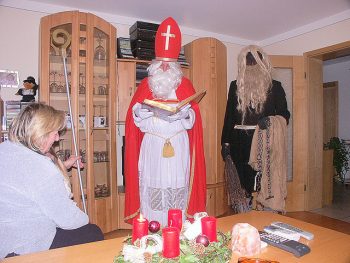Sometimes it can get a bit confusing: St Nicholas comes on the night of 5th of December, Santa Claus comes on the night of the 24th, and the Christkind arrives in the evening of the 24th! But who are they all and what is the unterschied (difference) between them?
Saint Nicholas
St Nicholas comes from Greece (now part of Turkey) and lived in the third century. He donated Geschenke (presents) and food to the poor by throwing them through the window. He died on the 6th of December which is why the night of the 5th is a remembrance day for him. I wrote a post all about him last year, if you want to know more then you can find it here.

St Nicholas with the Krampus. Photo by labormikro on Flickr under CC BY-SA 2.0
Santa Claus – der Weihnachtsmann
His name originates from the Dutch word Sinterklaas and he is actually St Nicholas! During the Protestant reformation the Church banned St Nicholas’ day, as they didn’t want a catholic saint to be remembered. The pilgrims who still wanted to keep the tradition changed the day to the 25th so they could remember St Nicholas as well as the birth of Jesus.
St Nicholas got his new image from various Gedichte (poems) and drawings. One of the most famous poems is “A visit from St. Nicholas” by Clement Clarke Moore (also known as “The Night Before Christmas”). Here he describes St Nicholas as how we know him:
“His eyes—how they twinkled! his dimples, how merry!
His cheeks were like roses, his nose like a cherry!
His droll little mouth was drawn up like a bow,
And the beard on his chin was as white as the snow;”
Das Christkind
The Christkind came from Martin Luther during the Protestant Reformation. The Christkind was created as the new gift bringer to eliminate St Nicholas. The christkind is a child like figure with blonde hair, meant to resemble Jesus as a child. My sister wrote a detailed post on the Christkind last year which you can find here.
I hope this post has cleared up any confusion! In short, St Nicholas was turned into Santa Claus, and the Christkind became the new gift giver to try and stop people remembering St Nicholas. Despite all that happened over the centuries each figure is still remembered every year.
Ich wünsche Euch allen frohe Weihnachten!
I wish you all a merry Christmas!
Larissa






Comments:
Jon:
Ok, but what about Der Weihnachtsmann? Rupert? Those are more German than Santa Claus.
L.G.
Jon
Larissa:
@Jon Hi Jon!
Thanks for your comment; der Weihnachtsmann ist just the German word for Santa, but thanks for pointing it out I’ll pop it in the post! I’m not quite sure who you mean by Rupert??
Larissa 🙂
alcazar:
Me thinks he means “Knecht Ruprecht”, companion of St. Nicolas like the Krampus.
Larissa:
@alcazar Ahhh thank you Alcazar!
Yes Ruprecht has a similar funktion to the Krampus. He doesn’t look as scary as the Krampus (see my post about the Krampus here) but also punishes children who have been bad, either by giving them coal and stones as presents or by hitting them with his stick!
Hope that helps,
Larissa 🙂
Brigitta Lake:
You did not mention the Weihnachtsmann who brings gifts in
northern Germany. He is generally accompanied by Knecht Ruprecht who carries a sack with a rod for children who had not been good.
Jon:
Actually, the Rupert/Ruprecht that I was referring to is not the Knecht Ruprecht who accompanies St. Nikolas or the Weihnachtsmann. I have often seen the more traditional American-style Santa Claus referred to as Rupert or Ruprecht. This seems to be particularly true with figures from the Erzgebirge. I wonder if this is a relic of DDR times to avoid using the American “Santa Claus”?